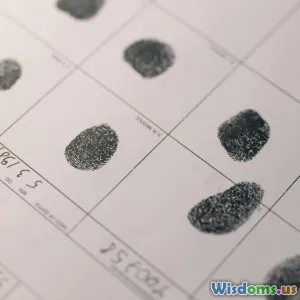
Innovations in Forensic Science
8 min read Explore groundbreaking forensic science innovations revolutionizing crime investigation today. (0 Reviews)
Innovations in Forensic Science: Revolutionizing Crime Investigation
Forensics has always been a cornerstone of effective crime investigation, illuminating the path from evidence to justice. Yet, as criminals grow more sophisticated, forensic science too has had to evolve dramatically. Today, innovations once confined to science fiction are breaking ground in criminology and crime investigation—untangling complex cases faster and more accurately than ever before.
The Dawn of a New Forensic Era
Once reliant solely on fingerprints and rudimentary chemical testing, forensic science now harnesses high-tech tools and interdisciplinary approaches. From DNA phenotyping to artificial intelligence, these advancements profoundly expand investigators' capabilities.
As renowned forensic expert Dr. Henry Lee aptly puts it, "Forensic science is not just about solving crimes; it's about telling the story that the perpetrator tried to erase."
Major Innovations in Forensic Science
1. Advanced DNA Analysis and Phenotyping
The cornerstone of modern forensics is undoubtedly DNA profiling, but recent strides extend well beyond traditional methods. One groundbreaking development is DNA phenotyping, which predicts a person’s physical appearance and ancestry from their genetic material.
- Example: In 2019, investigators in the Netherlands utilized DNA phenotyping to create a composite sketch of an unknown suspect’s face from crime scene DNA, leading to a crucial arrest.
- Data: According to the National Institute of Justice, phenotype prediction methods improve suspect prioritization by over 30%, especially when no eyewitness accounts exist.
Moreover, Rapid DNA sequencing technologies now deliver results in under two hours, a game changer in time-sensitive criminal inquiries.
2. Artificial Intelligence and Machine Learning
AI is revolutionizing crime scene analysis, evidence processing, and case linking in unprecedented ways.
- Digital Crime Scene Reconstruction: AI-driven software can create detailed 3D reconstructions from crime scene photos, enabling investigators to visualize events dynamically.
- Pattern Recognition: Machine learning algorithms analyze vast databases of case evidence to identify patterns otherwise imperceptible to humans. This is particularly impactful in cold case reviews.
For instance, the FBI’s scientific working group endorses AI tools that helped solve multiple older cases by cross-referencing modus operandi across jurisdictions.
3. Enhanced Trace Evidence Analysis
Trace evidence—fibers, paint chips, soil, or pollen—holds crucial clues but often evades detection due to its minute nature.
Innovations include:
- Spectroscopy with Hyperspectral Imaging: Allows forensic scientists to analyze materials’ chemical signatures without damaging the sample, preserving crucial evidence.
- Nano-extraction Techniques: Enable extraction and characterization of trace particles at the nanoscale, improving sensitivity and accuracy dramatically.
A case study from the University of Tennessee showed that hyperspectral imaging could differentiate carpet fibers from different manufacturers with 95% accuracy, aiding multiple murder investigations.
4. Digital Forensics and Cybercrime Investigation
As crime angles increasingly digitize, forensic science has adapted to the digital realm.
- Mobile Forensics: Advanced tools allow investigators to recover deleted data, decrypt communications, and analyze device usage patterns.
- Cloud Data Recovery: Novel techniques help law enforcement retrieve information stored on distributed cloud platforms, which were once virtually inaccessible.
In one landmark case, the FBI collaborated with international partners to decrypt evidence stored on cloud servers, leading to the takedown of a global cybercrime ring.
5. Biometric Innovations
Beyond fingerprints, biometric identification is blossoming with techniques like iris/impression recognition and vein pattern analysis.
- Innovative portable biometric scanners are now deployed on-site, securing faster suspect identification.
- Research into DNA methylation markers is underway to estimate criminal suspects’ age from biological samples, narrowing suspect pools significantly.
Real-World Impact: Success Stories of Innovation
- Operation Thunderbolt (UK Police, 2021): Utilized AI-enhanced analysis of CCTV combined with DNA phenotyping to arrest a suspect in a complex robbery within days.
- The Golden State Killer Case: Famous for advancing the use of genealogical DNA databases, demonstrating how forensic innovations can close decades-old cases.
Challenges and Ethical Considerations
Despite technological marvels, challenges persist.
- Privacy Concerns: Expansion of genetic databases provokes debates over individual rights and consent.
- Data Security: Enhanced digital evidence handling demands robust cybersecurity to prevent evidence tampering.
- Need for Standards: As innovative methods increase, standardization must ensure reliability, reproducibility, and legal admissibility.
The Future of Forensics
Looking ahead, integration of multidisciplinary approaches combining biology, chemistry, computer science, and criminology will deepen forensic precision. Emerging horizons include:
- Quantum Forensics: Utilizing quantum computing to handle complex data patterns beyond classical machines’ capacity.
- Real-Time On-Site Analysis: Portable, AI-driven devices performing instant trace analysis at crime scenes.
- Ethical AI Frameworks: Ensuring forensic AI tools respect fairness and non-bias in criminal justice outcomes.
Conclusion
Innovations in forensic science are reshaping the landscape of criminology and crime investigation beyond recognition. This fusion of cutting-edge technology with traditional investigative expertise accelerates justice delivery, uncovers hidden truths, and strengthens societal trust in law enforcement. For professionals and laypersons alike, understanding these advancements prompts a new appreciation: forensic science today is a profound detective of truth, armed with remarkable tools, unveiling stories from the minutest clues.
With continued ethical stewardship and technological refinement, the forensic field promises a future where no crime remains unsolved due to lack of evidence—an inspiring prospect for justice worldwide.
References:
- National Institute of Justice Reports on DNA Phenotyping (2022)
- FBI Scientific Working Group on Artificial Intelligence in Forensics (2023)
- University of Tennessee Hyperspectral Imaging Study (2021)
- Case files and public records from Operation Thunderbolt (UK, 2021)
Author: A Forensic Science Enthusiast | Date: 2024
Rate the Post
User Reviews
Popular Posts

















